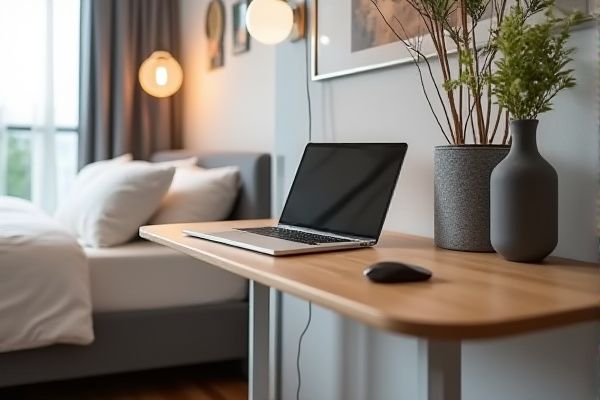
An overbed table offers a stable, adjustable surface ideal for eating or working while in bed, whereas a lap desk provides a portable, cushioned platform suitable for use on the couch or chair. Discover which option best suits Your needs and preferences by reading the rest of the article.
Table of Comparison
| Feature | Overbed Table | Lap Desk |
|---|---|---|
| Primary Use | Provides a stable surface over a bed for eating, working, or reading | Portable surface for working or reading while seated or lying down |
| Design | Height adjustable with legs that fit over the bed | Compact, lightweight, designed to rest on the lap |
| Portability | Less portable due to size and structure | Highly portable and easy to carry |
| Surface Area | Large surface suitable for meals, laptops, or books | Smaller surface, ideal for laptops, tablets, or notebooks |
| Adjustability | Adjustable height and angle | Usually fixed height, some models offer tilting surfaces |
| Comfort | Allows comfortable working or eating in bed | Provides comfort but may cause heat or weight on lap |
| Price Range | $30 - $150 depending on features and build quality | $10 - $70 for basic to premium models |
| Best For | Bedridden users, patients, or anyone needing stable surface in bed | Students, remote workers, casual users needing mobility |
Introduction: Overbed Table vs Lap Desk
Overbed tables provide a stable, adjustable surface ideal for working, eating, or reading in bed or while seated, offering ergonomic support and ample space. Lap desks are portable, compact, and lightweight, perfect for casual use on your lap but less stable for heavier tasks. Your choice depends on whether you prioritize mobility and convenience or stability and adjustability for extended use.
Purpose and Use Cases
Overbed tables are designed primarily for patients or individuals who need a stable surface while lying in bed, facilitating activities like eating, reading, or using a laptop in a healthcare or home care setting. Lap desks offer portable convenience for those working or relaxing on couches, chairs, or beds, providing a compact surface for writing, laptops, or tablets without the need for additional furniture. The choice between the two depends on mobility needs, space constraints, and the specific environment in which the surface will be used.
Design Features Comparison
Overbed tables feature adjustable height and a stable, large surface designed for use in bed, offering wheels for easy mobility and secure positioning. Lap desks prioritize portability with lightweight construction, cushioned bases for comfort, and compact surfaces ideal for use on couches or chairs. The overbed table supports heavier items and multitasking, while lap desks excel in convenience and flexibility for casual use.
Material and Durability
Overbed tables typically feature sturdy materials such as metal frames and laminated wood or MDF tops, providing excellent durability and stability for extended use in medical or home care settings. Lap desks are often crafted from lightweight materials like plastic, bamboo, or plywood, prioritizing portability but sometimes sacrificing long-term durability. Choosing between the two depends on whether stability and robustness or mobility and convenience are the primary concerns.
Comfort and Ergonomics
Overbed tables provide adjustable height and surface area, promoting optimal posture and reducing strain on the neck and back during prolonged use. Lap desks offer portability and cushioned support, but may cause poor alignment and increased pressure on the lower back due to fixed positioning. Choosing between the two depends on the user's mobility needs and sustained comfort preferences for ergonomics.
Adjustability and Mobility
Overbed tables offer superior adjustability with height and angle customization, making them ideal for various activities while in bed or seated. Lap desks provide portability and easy mobility, allowing you to work or eat comfortably from any location without setup. Choosing between the two depends on your need for stable, adjustable surfaces versus convenient, on-the-go use.
Space-Saving Benefits
Overbed tables offer significant space-saving benefits by providing a stable surface that fits over beds, eliminating the need for additional furniture in tight rooms. Lap desks, while portable and compact, require no setup but may limit workspace size and comfort during extended use. Choosing an overbed table maximizes floor space and supports multitasking, whereas lap desks optimize personal mobility and minimal storage footprint.
Price Range and Value
Overbed tables typically range from $50 to $200, offering adjustable height and ample surface space, which provides excellent value for users needing stability and versatility. Lap desks are generally more affordable, often priced between $15 and $60, making them ideal for lightweight tasks and portability but with less ergonomic support. The choice depends on balancing budget constraints with the need for functionality and comfort during prolonged use.
Pros and Cons of Overbed Tables
Overbed tables offer adjustable height and a stable surface, making them ideal for eating, working, or reading in bed, which enhances comfort and convenience for recovery or limited mobility. However, their larger size can limit portability and require sufficient space around the bed, making them less practical for frequent relocation. Your choice depends on whether stability and accessibility outweigh the need for mobility and compact use often provided by lap desks.
Pros and Cons of Lap Desks
Lap desks offer portability and ergonomic support, making them ideal for working or eating comfortably on a couch or bed. They typically provide a flat surface with built-in wrist rests or cushions, promoting better posture and reducing strain. However, lap desks lack the adjustable height and stability of overbed tables, which may limit their use for extended tasks or heavier items.
 homyna.com
homyna.com